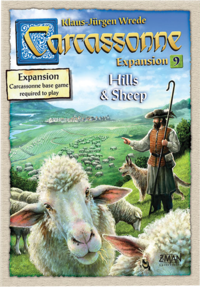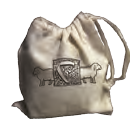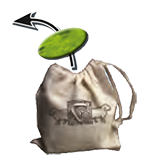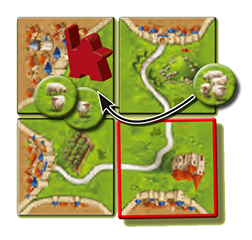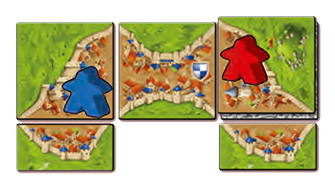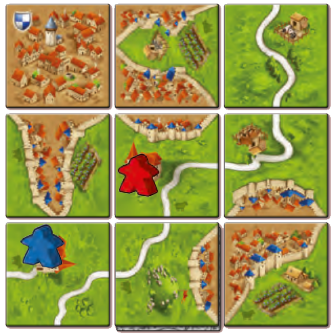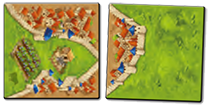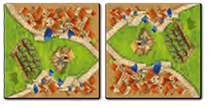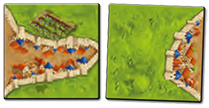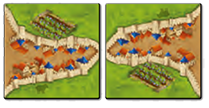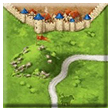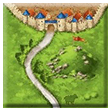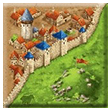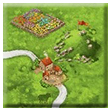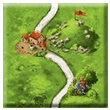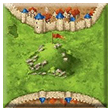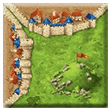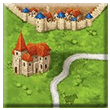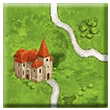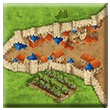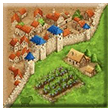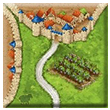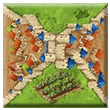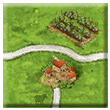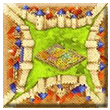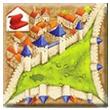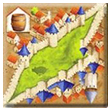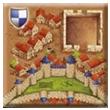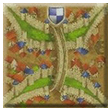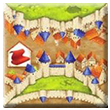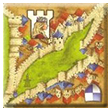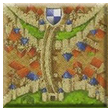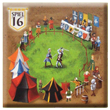Schapen en Heuvels
General info and comments
De nieuwe editie van Schapen en Heuvels werd in Template:Year nl uitgegeven door Hans im Glück.
Dit is de negende grote uitbreiding voor het basisspel en introduceert een aantal nieuwe aspecten in het spel.
De herders op de weiden rondom Carcassonne wachten geduldig tot hun kudde schapen zich verzamelt. Ze moeten alleen wel uitkijken dat er geen wolf opduikt voordat ze hun kudde veilig naar de stal hebben gedreven. Vanaf de heuvels kun je de controle krijgen over wat eerst verloren leek. En verder is menig monnik maar wat blij met een wijngaard in de directe omgeving van zijn klooster.
Inhoud
- 18 landtegels
- 18 schaaps- en wolfsfiches (4x 1 schaap, 5x 2 schapen, 5x 3 schapen, 2x 4 schapen, 2x wolf)
- 1 buidel
- 6 herders in 6 kleuren
Spelregels
Voorbereiding
Doe alle schaaps- en wolfsfiches in de buidel. Geef elke speler (inclusief jezelf) de herder in zijn kleur. Schud de nieuwe landtegels door de andere landtegels.
Met uitzondering van de nieuwe spelregels die bij deze uitbreiding van toepassing zijn, blijven de basisspelregels van Carcassonne ongewijzigd van kracht.
Herders, schapen en wolven
2. Een herder zetten
Na het aanleggen van een tegel met een weide, mag je kiezen of je zoals gebruikelijk een meeple zetten of je herder op de weide zetten. Zet je je herder, dan trek je direct een fiche uit de buidel.
Is het een schaapsfiche, dan leg je die bij je herder op de weide.
Is het een wolfsfiche, dan doe je die terug in de buidel en neem je je herder terug in voorraad.
Je mag je herder ook in een weide met een boer zetten (en omgekeerd), maar niet in een weide met een andere herder. De herder is een speciaal speelstuk, geen meeple.
Tijdens het spel heeft de herder de volgende functie:
1. Landtegel leggen
Als jij een tegel legt waardoor je de weide van je herder vergroot, voer je eerst zoals gebruikelijk de actie 2. Een meeple zetten uit. Vervolgens mag je één van de volgende twee acties uitvoeren:
- Kudde uitbreiden (fiche uit de buidel trekken)
OF
- Kudde naar de stal drijven (schapen tellen)
Kudde uitbreiden
Trek een fiche uit de buidel:
| File:Hills And Sheep C2 Token 3.png | 1. | Als het een schaapsfiche is, wordt je kudde groter. Leg het schaapsfiche bij de andere schaapsfiches bij je herder. |
| File:Hills And Sheep C2 Token W.png | 2. | Als het een wolfsfiche is, wordt je kudde uiteengejaagd. Doe alle schaapsfiches die bij je herder op de weide lagen terug in de buidel en neem je herder terug in voorraad. |
Kudde naar de stal drijven
Tel van elk schaapsfiche op de weide met jouw herder het aantal schapen wat op het fiche staat. Dit is het aantal punten wat je krijgt. Doe vervolgens de schaapsfiches terug in de buidel en neem je herder terug in voorraad.
Meerdere herders op en weide
Als losse weiden met herders later in het spel worden verbonden, kunnen er meerdere herders op een weide staan. Iedere speler die een herder op die weide heeft mag zoals gebruikelijk de kudde uitbreiden of de kudde naar de stal drijven, maar deze acties worden anders afgehandeld:
- Wordt er een schaapsfiche getrokken, dan wordt dat fiche zoals gebruikelijk neergelegd. Wordt er een wolfsfiche getrokken, dan gaan alle schaapsfiches van die weide terug naar de buidel en nemen de betrokken spelers hun herder terug in voorraad.
- Leidt een speler de kudde naar de stal, dan worden de schapen op alle schaapsfiches op de weide geteld en de fiches gaan terug naar de buidel. Iedere speler met een herder op die weide krijgt de betreffende punten.
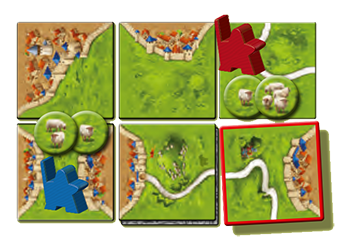
Had je ervoor gekozen de kudde uit te breiden en een wolfsfiche getrokken, hadden alle herders teruggenomen moeten worden en alle schaapfiches van de weide waren teruggegaan naar de buidel, en had niemand punten gekregen.
Om punten te krijgen voor je schapen, moet je normaalgesproken de actie kudde naar de stal drijven uitvoeren.
Uitzondering: Als een speler een weide met herders en schapen door middel van wegen of stadsmuren volledig afbouwt, dan volgt automatisch de actie Kudde naar de stal drijven voor die weide.[1] [2]
3. Puntentellingen afhandelen
De herder krijgt geen punten voor andere projecten en wordt niet beïnvloed door andere tellingen.
Eindtelling
Als jouw herder en schapen aan het einde van het spel nog op een weide staan, krijg je er geen punten meer voor.
Heuvels
1. Landtegel leggen
Trek je een tegel met een heuvel, dan trek je direct nog een gedekte tegel en schuif je die onder de heuveltegel. Je mag de tweede tegel niet bekijken! Leg de tegel volgens de gebruikelijke regels aan. De gedekte tegel blijft eronder.[3]
2. Een meeple zetten
Na het aanleggen van de heuveltegel mag je op de gebruikelijke wijze een meeple zetten (op één van de projecten: weg, stad, weide). Je mag geen meeple op de heuvel zelf zetten.
3. Scoring a hill
If you have a meeple on a feature of a hill tile, ties for scoring that feature are broken in your favor. When a feature is scored (road, city, and field), if players are tied for most meeples, check to see if any part of that feature appears on a hill tile. If it does, and if one of the tied players has a meeple on that feature of the hill tile, that player breaks the tie and is the only player who scores points for that feature. Unlike ties without hills, other tied players do not score any points. [4] [5]
Having a meeple on a hill only affects ties when scoring a feature. If there is not a tie, the hill provides no additional effect. After a feature is scored, a meeple on a hill tile is returned to its owner's supply as normal.
Final Scoring
Meeples on hill tiles break ties and score points as normal during final scoring (including farmers).
Vineyards
1. Placing a tile
You place a tile with a vineyard as normal.
2. Placing a meeple
After placing the vineyard tile, you may place a meeple on the tile as normal, but you cannot place the meeple directly on the vineyard itself.
3. Scoring a vineyard
When completing and scoring a monastery, the player who scores points for the monastery scores 3 additional points for each vineyard on one of the 8 surrounding tiles. A single vineyard can score additional points for multiple monasteries.
Final Scoring
During final scoring, an incomplete monastery does not score additional points for the surrounding vineyards. [6]
New land tiles

|
This tile has two seperate city segments. If you place a tile with one city segment to the right of it, the city segments become connected. |

|
This tile has two separate field segments. If you place a tile with one field segment to the right of it, the field segments become connected. |
Other expansions
This section contains additional information about the interactions with other Carcassonne expansions.
Shepherds, sheep and wolves
- The following figures can share a field with your shepherd without any effect on either figure:
- Normal meeple, the standard option (Base game)
- Large meeple (Exp. 1 - Inns and Cathedrals)
- Pig (Exp. 2 - Traders and Builders)
- Barn (Exp. 5 - Abbey & Mayor)
- Ringmaster (Exp. 10 - Under the Big Top)
- Phantom (The Phantom)
- Exp. 3 - The Princess and the Dragon: The dragon will eat only the shepherd (and that shepherd's flock) on its tile. It will not eat other shepherds from the same field unless it moves onto the corresponding tile. The shepherd is not a meeple, so the fairy cannot be assigned to it.
- Exp. 4 - The Tower: You cannot capture a shepherd with a tower.
- Exp. 6 - Count, King and Robber: You cannot place your shepherd into the city of Carcassonne.
Hills
- The following figures can use the hill's tiebreaking effect:
- Normal meeple, the standard option (Base game)
- Large meeple (Exp. 1 - Inns and Cathedrals)
- Wagon (Exp. 5 - Abbey & Mayor)
- Mayor, if there is a coat of arms in the city (Exp. 5 - Abbey & Mayor)
- Meeple on a bridge that is on a hill tile (Exp 8. - Bridges, Castles and Bazaars)
- Ringmaster (Exp. 10 - Under the Big Top)
- Phantom (The Phantom)
- Exp. 5 - Abbey & Mayor: You cannot place an abbey tile under a hill tile. A hill can be part of the tile junction that the barn is placed on, but there is no additional effect.
- Exp. 6 - Count, King and Robber: You may deploy a meeple from from the city of Carcassonne on a hill tile with a feature about to be evaluated. [7] If you do, you gain the benefit of the hill.
- Exp. 8 - Bridges, Castles and Bazaars: You can place a bridge on a hill tile. You can place a castle (even partially) on a hill tile. If you take a hill tile during a bazaar auction, do not take the facedown tile (to put under the hill) until it is your turn to place the hill tile.
Vineyards
- The following figures can use the effect of the vineyard when scoring a monastery:
- Normal meeple, the standard option (Base game)
- Abbot (Base game - The Abbot)
- Large meeple (Exp. 1 - Inns and Cathedrals)
- Wagon (Exp. 5 - Abbey and Mayor)
- Ringmaster (Exp. 10 - Under the Big Top)
- Phantom (The Phantom)
- Base game - The Abbot: Your abbot can score additional points for vineyards only if the monastery is scored when completed. If you return the abbot before then, you do not score the additional points. [8] [9] If the abbot is placed on a garden, you do not score additional points for vineyards.
- Exp. 5 - Abbey & Mayor: Abbeys can score additional points for vineyards.
- Exp. 6 - Count, King and Robber: Shrines can score additional points for vineyards. If there is a challenge, you score the additional points only if you win the challenge.
- Exp. 8 - Bridges, Castles and Bazaars: You can place a bridge on a vineyard tile.
- Monasteries in Germany / Japanese Buildings: When using German monasteries or Japanese buildings, the vineyard bonus is applied if the meeple is placed as a monk and the feature is scored as a finished monastery. However, the vineyard bonus is not applied if a meeple is placed as an abbot, as the abbot scores only at the end of the game, when the vineyard has no effect.
House rules
- If you’re not concerned about whether or not players count tiles as a strategy, and you want to be able to use all of the tiles in the game, you can place blank tiles under any hills that are drawn. (Thanks to Crispy Jones.)
Tile distribution
Total Tiles: 18
Several tiles have a small illustration on them. The letters in brackets show which illustration is on each tile:
Total Tokens: 18
Footnotes
For Icons explanation and licensing please visit Icons page.
- ↑
 Deze uitzondering heeft betrekking op de speciale situatie dat een weide omringd en "afgesloten" wordt door wegen en steden zodat deze niet meer uitgebreid kan worden. Op dat moment vindt er een puntentelling voor de herder plaats: de speler krijgt punten voor de schapen op de fiches, de schaapsfiches gaan terug in de buidel, en speler neemt zijn herder terug in voorraad. (12/2015)
Deze uitzondering heeft betrekking op de speciale situatie dat een weide omringd en "afgesloten" wordt door wegen en steden zodat deze niet meer uitgebreid kan worden. Op dat moment vindt er een puntentelling voor de herder plaats: de speler krijgt punten voor de schapen op de fiches, de schaapsfiches gaan terug in de buidel, en speler neemt zijn herder terug in voorraad. (12/2015)
De weide wordt op dit moment niet geteld. De afgesloten weide wordt zoals gebruikelijk aan het einde van het spel geteld. - ↑
 Dezelfde uitzondering is van toepassing als je een herder op een binnenweide zet. Op diverse SSSS- of SSSW-tegels staat een binnenweide die volledig ommuurd is en niet uitgebreid kan worden. In dit geval, zet je de herder op de binnenweide, voer je de actie Kudde uitbreiden uit en, mits je geen wolfsfiche trok, volgt automatisch de actie Kudde naar stal drijven aangezien de weide al afgesloten is. Dit zijn voorbeelden van SSSS-tegels met binnenweiden:
Dezelfde uitzondering is van toepassing als je een herder op een binnenweide zet. Op diverse SSSS- of SSSW-tegels staat een binnenweide die volledig ommuurd is en niet uitgebreid kan worden. In dit geval, zet je de herder op de binnenweide, voer je de actie Kudde uitbreiden uit en, mits je geen wolfsfiche trok, volgt automatisch de actie Kudde naar stal drijven aangezien de weide al afgesloten is. Dit zijn voorbeelden van SSSS-tegels met binnenweiden:
Dit zijn voorbeelden van SSSW-tegels met binnenweiden:
Op de volgende SSSS-tegel staat geen binnenweide omdat deze niet zoals een normale weide door muren of wegen wordt omringd. Het grasveld is slechts een illustratie van een steekspel. (Hoe dan ook, het zou ook een raar zicht zijn, herders en schapen tussen ridders in een steekspel, niet?)
- ↑
 Als de heuveltegel de laatste tegel van het spel is, mag de speler die nog steeds aanleggen zonder dat er een tweede tegel onder zit. Vervolgens wordt de beurt op de normale wijze (hout verplaatsen, puntentellingen afhandelen) afgerond. Merk op dat het gewonlijk niet mogelijk is om met deze tegel een tiebreak te veroorzaken – zelfs niet als je er een meeple op zet, aangezien het niet mogelijk is om die meeple met een bezet project te verbinden aangezien het spel voorbij is. (10/2014)
Als de heuveltegel de laatste tegel van het spel is, mag de speler die nog steeds aanleggen zonder dat er een tweede tegel onder zit. Vervolgens wordt de beurt op de normale wijze (hout verplaatsen, puntentellingen afhandelen) afgerond. Merk op dat het gewonlijk niet mogelijk is om met deze tegel een tiebreak te veroorzaken – zelfs niet als je er een meeple op zet, aangezien het niet mogelijk is om die meeple met een bezet project te verbinden aangezien het spel voorbij is. (10/2014)
- ↑
 If the tied players also have equal numbers of meeples on hills in that feature, the tie remains unbroken and both players still receive the points. Even if the number of meeples on hills is unequal, as long as each of the tied players has at least one meeple on a hill, the tie is unbroken and both players receive the points. (5/2014)
If the tied players also have equal numbers of meeples on hills in that feature, the tie remains unbroken and both players still receive the points. Even if the number of meeples on hills is unequal, as long as each of the tied players has at least one meeple on a hill, the tie is unbroken and both players receive the points. (5/2014)
- ↑
 As an alternative tiebreaker method, the number of meeples on hills can be counted. Thus, if two players have the same number of meeples in a feature, but one player has more of those meeples on hills than the other player does, the player with the most meeples on hills gets all of the points and the other player gets none. (5/2014)
As an alternative tiebreaker method, the number of meeples on hills can be counted. Thus, if two players have the same number of meeples in a feature, but one player has more of those meeples on hills than the other player does, the player with the most meeples on hills gets all of the points and the other player gets none. (5/2014)
- ↑
 Regardless of the type of monastery involved (normal cloister, abbey, shrine, German monastery or Japanese building), the vineyard has no effect on final scoring at the end of the game. (5/2014)
Regardless of the type of monastery involved (normal cloister, abbey, shrine, German monastery or Japanese building), the vineyard has no effect on final scoring at the end of the game. (5/2014)
- ↑
 We updated this sentence according to the the German rules. The rules by ZMG contain a mistranslated version of this sentence: "You can place one meeple from the city of Carcassonne on a hill tile with a feature that has not been completed."
We updated this sentence according to the the German rules. The rules by ZMG contain a mistranslated version of this sentence: "You can place one meeple from the city of Carcassonne on a hill tile with a feature that has not been completed."
- ↑
 If an abbot is removed from a completed monastery in phase 2. Placing a meeple, it will not get points for any adjacent vineyards, since the feature is not scored in phase 3. Scoring a feature when vineyards are applied.
If an abbot is removed from a completed monastery in phase 2. Placing a meeple, it will not get points for any adjacent vineyards, since the feature is not scored in phase 3. Scoring a feature when vineyards are applied.
- ↑
 We updated the wording to make it closer on the German rules and avoid the ambiguity that affected the removal of the abbot when the monastery was completed. The original English wording is: "Your abbot can score additional points for vineyards only if the monastery is completed. If you return the abbot before the monastery is completed, you do not score the additional points."
We updated the wording to make it closer on the German rules and avoid the ambiguity that affected the removal of the abbot when the monastery was completed. The original English wording is: "Your abbot can score additional points for vineyards only if the monastery is completed. If you return the abbot before the monastery is completed, you do not score the additional points."
- Editor Manual - Old numbered parameters - RulesPlacingMeeple
- Editor Manual - Old numbered parameters - RulesPlacingTile
- Editor Manual - Old numbered parameters - RulesScoring
- Editor Manual - Old numbered parameters - Tile
- Old template
- Old template - FootnoteIconPara en
- Second Edition
- Second Edition Major Expansion
